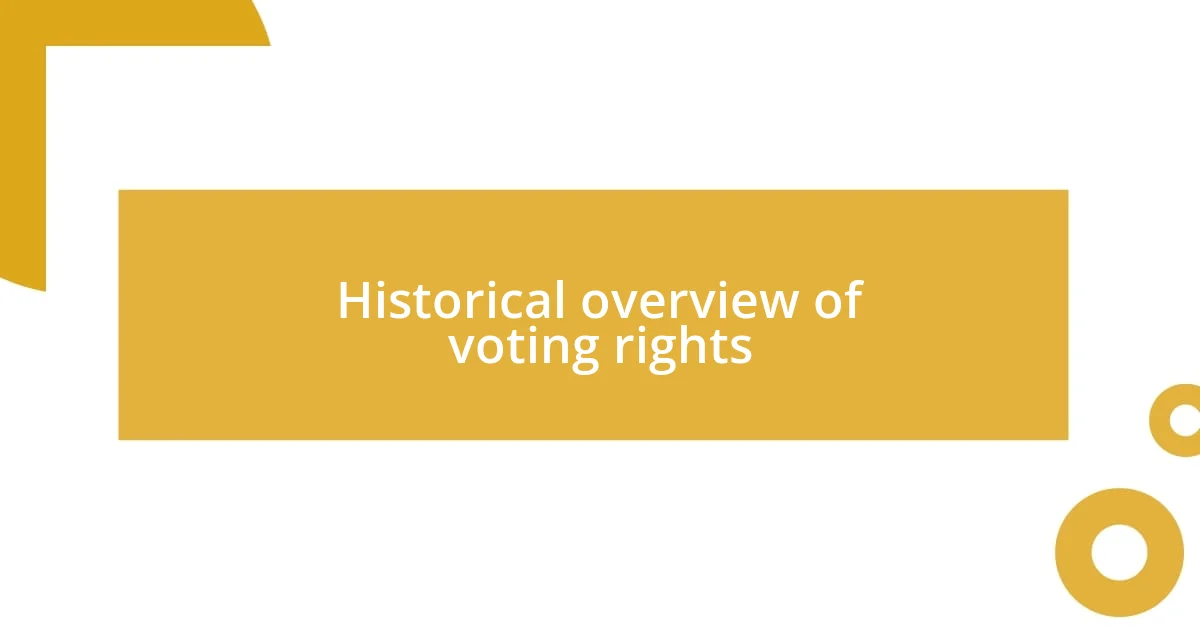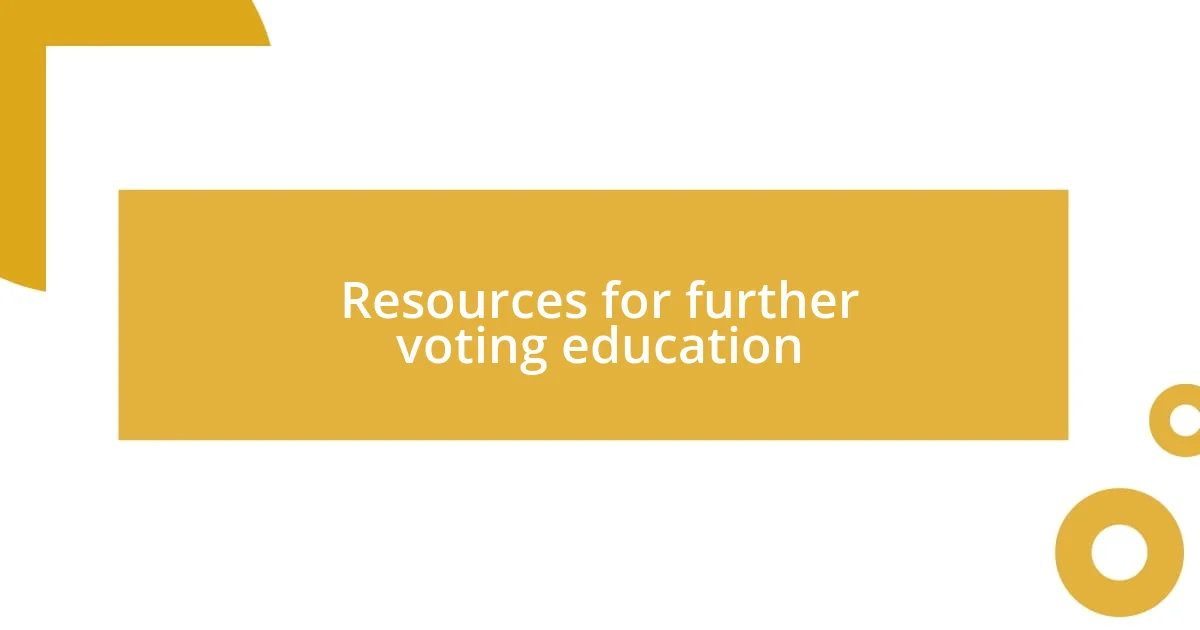Key takeaways:
- The Voting Rights Act of 1965 was a landmark legislation that aimed to dismantle barriers preventing marginalized communities from voting.
- Current challenges to voting access include restrictive voter ID laws, gerrymandering, and the digital divide, which hinder participation.
- Educational resources, such as the League of Women Voters and relevant literature, are vital for understanding and advocating for voting rights.

My interest in voting rights
My interest in voting rights sparked during my college years when I volunteered for a local campaign. Witnessing the passion and determination of people advocating for access to the polls opened my eyes to the struggle many face just to make their voices heard. It made me wonder—why are some voices amplified while others remain silenced?
I remember sitting in a café one afternoon, chatting with a group of friends about the importance of inclusive representation. Their stories—about family members who faced obstacles when trying to vote—resonated deeply with me. It was in that moment I realized voting rights are not just a political issue; they’re personal and emotional, tied to the lives and aspirations of individuals and communities.
As I delved deeper into the history and laws surrounding voting rights, I became increasingly frustrated. Why, in a democracy, should anyone feel disenfranchised or marginalized? Exploring this topic has transformed my understanding, fueling a desire to advocate for change. It starkly clarified one thing for me: every vote truly matters, and ensuring everyone can cast theirs is crucial for our collective future.

Historical overview of voting rights
As I explored the historical context of voting rights, I was struck by how tumultuous and uneven the journey has been. From the early days of our nation, voting was primarily reserved for white male landowners. The struggle for broader suffrage is a testament to the relentless fight for equality.
- Although the 15th Amendment granted African American men the right to vote in 1870, many were still met with barriers such as literacy tests and poll taxes.
- Women fought valiantly and secured the right to vote with the 19th Amendment in 1920, yet racial minorities, including women of color, continued to face discrimination at the polls.
- The Voting Rights Act of 1965 marked a pivotal point, outlawing discriminatory practices that hindered access to voting, but it was a hard-won battle fueled by courage and unity.
Reflecting on this historical overview, I can’t help but admire the activists and everyday citizens who were undeterred in the face of hardship. Their determination resonated with me personally, reminiscent of feeling underestimated, yet still standing firm in pursuit of rights that others often take for granted. Understanding their journey has deepened my appreciation for the ongoing fight for voting rights and my role in fostering change.

Key legislation on voting rights
Throughout my journey to understand voting rights, I’ve come across significant legislation that marks critical milestones in this ongoing struggle. One landmark moment was the Voting Rights Act of 1965, which was crucial for dismantling barriers that prevented many marginalized communities from voting. I remember reading stories about the march from Selma to Montgomery, which really drove home the sacrifices people made for this right. It reminded me of how activists often mobilize under dire circumstances, pushing for a change that should be commonplace.
Another important piece of legislation is the Help America Vote Act of 2002. This law was enacted to improve voter registration and voting systems after the 2000 presidential election revealed severe flaws. I think back to conversations with my peers about their voting experiences and how technological advancements—like online registration—have made the process more accessible. It’s heartening to see that legislation can adapt and respond to past mistakes, aiming to enhance democracy for everyone.
Comparatively, while the Voting Rights Act sought to remove discriminatory practices, the Help America Vote Act focused on modernizing the voting process itself. Each plays a distinct yet complementary role in ensuring that every eligible citizen can exercise their right to vote without unnecessary hurdles. I often ask myself: how can we build on these foundations to create even more inclusive systems? The answer lies in continuous advocacy and education.
| Legislation | Year Enacted |
|---|---|
| Voting Rights Act | 1965 |
| Help America Vote Act | 2002 |

Current challenges in voting access
Access to voting today faces significant challenges that often feel both daunting and disheartening. For instance, restrictive voter ID laws have emerged in several states, creating barriers for individuals who may not have easy access to the required identification. I recall a conversation with a friend who shared her frustration when she encountered these regulations—she wasn’t able to vote simply because she lacked a specific form of ID. How can we claim to be a democracy if so many faces are left unseen at the polls?
Moreover, issues like gerrymandering continue to complicate the landscape of voting access. This practice, which involves drawing district lines to benefit a particular party, can dilute the power of certain communities. I remember feeling stunned when I first learned how this manipulation can effectively disenfranchise voters. Isn’t it baffling that our representation can be compromised not by the choices of people, but by the strategic moves of politicians? It makes me wonder how many voices go unheard because of decisions made in back rooms rather than at the ballot box.
Lastly, we mustn’t overlook the digital divide, which increasingly affects voter registration and participation. As technology becomes integral to the voting process, individuals lacking internet access or digital literacy face hurdles that could prevent them from casting their vote. I once tried to help a neighbor register online, and it opened my eyes to how intimidating those platforms can be for someone not familiar with technology. What does it say about our system when participation hinges on access to the latest tools? Addressing these challenges is critical for ensuring that every vote counts and that democracy is truly inclusive.

Resources for further voting education
When it comes to furthering education on voting rights, a wealth of resources is available. I personally found the League of Women Voters to be a great starting point. Their website offers nonpartisan information about voting processes, upcoming elections, and even guides on how to advocate for voting rights in your community. Did you know they also host local events? I remember attending one and walking away not only informed but inspired to make a difference.
Books can also serve as valuable resources for understanding the complexities of voting rights. I stumbled upon “One Person, No Vote” by Carol Anderson, which provides an in-depth look at the historic and ongoing struggles against voter suppression. The narratives shared really resonated with me and helped deepen my understanding of systemic issues. How often do we overlook the stories behind the statistics? Engaging with these texts can spark meaningful conversations and awaken a desire for change.
Lastly, community organizations often provide workshops and informational sessions that can be eye-opening. I remember volunteering at a local nonprofit that focused on educating underprivileged communities about their voting rights. Witnessing individuals gain confidence and knowledge through these sessions was incredibly rewarding. Have you ever seen the light in someone’s eyes when they realize they have the power to influence their future? It’s moments like these that remind us that education is a powerful tool in the fight for voting rights.














